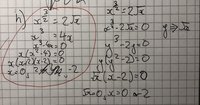I have an equation which is relatively basic. It’s just I’ve never really had positive and negative solutions fully explained to me, and an answer to this would properly explain it. See the question below.
The working circles in red is my initial attempt, which is all mathematically correct as far as I can tell, yet the solutions are 0,2 as well as -2 whereas in the right solution on the right the solutions are correct and are just 0 and 2. Please show me where I’ve gone wrong in my working.

The working circles in red is my initial attempt, which is all mathematically correct as far as I can tell, yet the solutions are 0,2 as well as -2 whereas in the right solution on the right the solutions are correct and are just 0 and 2. Please show me where I’ve gone wrong in my working.

